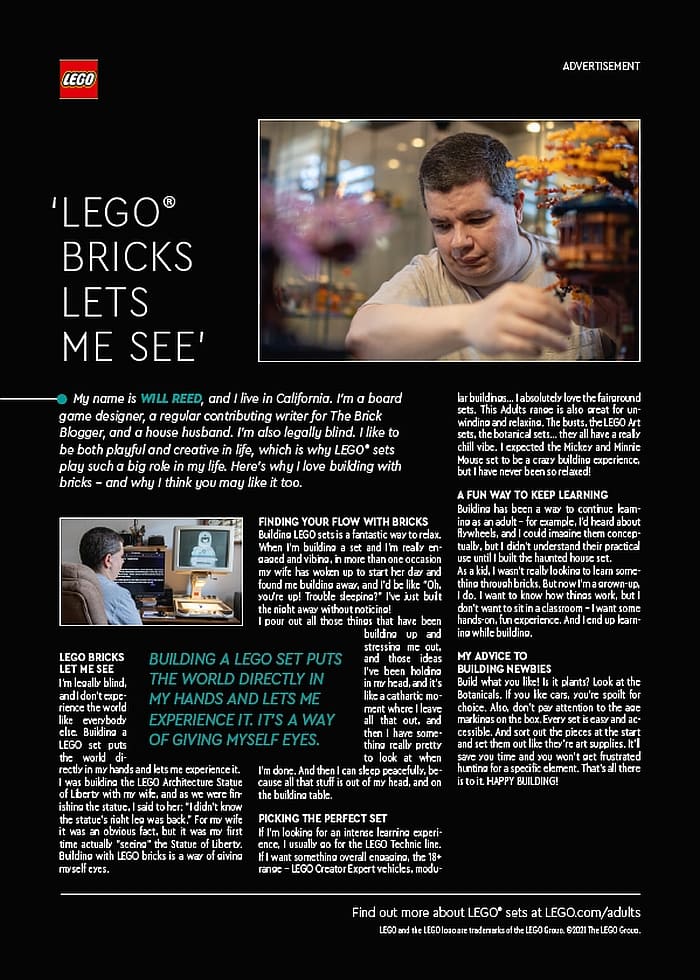(Written by William)
Over the last year or so, we’ve been introduced to a whole new world of LEGO. Many sets now come with the label of 18+ to show they are being marketed towards adults. In order to get the word out, LEGO has launched a substantial campaign to reach the target audience.
Seeing as I am an adult (in most cases), and LEGO plays a significant role in my life, I was asked to participate in this marketing campaign. The idea is that I would be interviewed and featured in a one-page advertisement in various magazines. As I’m legally blind means I also have an interesting human interest angle to share. Plus, it shows just how accessible LEGO sets can be, given the fact I’m enjoying myself despite my impairment. Below is the end result! (Click on image or click link for full PDF version.)

PREPARATION IS HALF THE PROCESS
Of course, before we got to the slick-looking ad, there was a bit of prep work that went into all of it. My hat goes off to the coordinator here. First, they had to get my information so that they could get some paperwork done. I needed to sign a photo release so that any images of me could even be used. Next, I was put in touch with the writer of the piece.
Considering the writer was in Denmark and I am in California in the states, there was the whole issue of a nine-hour time difference. Keep in mind, this was what the coordinator was dealing with as well and all this needed to get done in time for the launch of the campaign.
I was then given a list of questions to prepare me for the interview. This was so that I had plenty of time to really consider my answers and not give bland uninformative responses. All of this was to help make a forty-five minute interview productive.
After the interview was done and a draft was written, it was time for some good pictures to be taken. I did provide them with some rough images. However, considering I’m not a photographer nor do I have the proper equipment, it is safe to say what I initially provided was unusable. This meant a professional photographer had to be scheduled to come to me.
Let’s just say, a whole lot of effort went into this advertisement. Of course, I had a blast the entire time, so it really didn’t feel like work. Now let me talk about the interview process and then the photo-shoot.
THE INTERVIEW
The questions asked were the same as what was provided. However, they were more or less points for the author to start from. If something interesting came up in one of my answers, we’d veer off and talk about whatever that tangent was.
I must admit, I wasn’t expecting to get emotional. But as they dug down and asked me what LEGO means to me, it hit me, LEGO gives me eyes! When I gave that specific answer, we both kind of choked up.
Each day there are barriers in my life that I work through. My vision has gotten to the point where I can’t just play any video game anymore. Reading my mail is a chore. Heck, I can’t just decide to go for a walk or a run, as I can literally hurt myself, since I might not see some obstacle.
But when it comes to LEGO, those barriers are gone. I can write articles about the finer points of building. I can express my artistic side through things I create. It’s even possible to learn about others through the way we interact with these little plastic parts.
Ultimately, the interview showed me something about myself I hadn’t considered fully. Playing with LEGO bricks helps me on so many levels. I think the writer said it best when we talked, “I feel bad that I only have a page. I could write a book with what you’re telling me”.
THE PHOTO-SHOOT
Don’t worry, the entire process wasn’t all serious, learning deep truths about myself. We also had to put a face to this story. And since the face in question is mine, they needed to get a camera over to me.
We scheduled out four hours to get the right shots. There were a few requirements. It was absolutely necessary to get two specific images and, if there was time, try for a third. The two crucial shots involved me being absorbed in the building process and me working on writing up a piece at my desk. It’s actually super weird talking about getting the second image since I’m currently at my desk writing this piece. Oh, and the third picture if it was possible, was to see me in my element. In other words, if I were to open up a set and start building, whatever that would look like.

It brought a smile to my face bringing in the photographer and their two assistants to my LEGO room. They immediately gravitated towards the sets LEGO wants adults to find interesting. The LEGO Botanical Collection, the #10292 LEGO Adidas Superstar, and the #21318 LEGO Ideas Tree House were some of their favorites. As you can tell, the Tree House sort of won out since it’s one of the images in the ad.
Funny story about that picture of me and the Tree House. I was supposed to be looking like I was absorbed in the model. To be honest, I was absorbed. It had been sitting on display for a while and I found the model quite dusty. So during the entire shoot with the Tree House I was intensely trying to clean it off. That is why I’m so focused on the model. I’m not sure how many pictures were taken, but just getting that one image was a two-and-a-half-hour process.

The next image was a bit simpler. My office at home is not terribly big and it doesn’t have as many distractions as my LEGO room. In the photo, you can see two screens. The one on the left is my actual computer and I have assistance software running to change the color of the screen and enlarge what’s on the monitor. I was actually writing the first draft of my review of the the #21327 LEGO Ideas Typewriter.
The screen on the right has a large minifigure head on it. This is a different piece of assistive technology. I can put objects underneath the screen and a camera will enlarge them enabling me to see whatever it is better. Minifigure faces are one such thing I will examine from time to time. Though as you might know, there are no minifigures in the LEGO Ideas Typewriter set, so this was more of an artistic choice. That image took about an hour to get.
This left about a half hour to try for a third image. My guess is this lack of time prevented us from finding the right set up. This is also where things got even more artistic. The angles and setups for these images felt very unreal to me. Don’t get me wrong, each shot was extremely interesting to look at. The composition was stunning, the perspectives were unique, the colors on display were engaging, however I think that might be part of the reason why they weren’t used.
The feeling and tone I get from the ad is that everything is approachable and down to earth. You don’t want to scare off potential fans with something larger than life. That’s why a guy like me works so well. I’m nowhere near model pretty, I’m just a guy with a slightly interesting story.
Though I do have another funny story about the possible third image. Originally my wife and I were going to sit down at our table and just continue building the LEGO Ideas Typewriter that I already started but haven’t finished at that point. The photographer took one look at us and said, “No, that doesn’t work. It looks too staged”.
What followed next was what I can only describe as odd. We found ourselves in big comfy armchairs a few feet apart from one another. I think we even had something decorative between us. Meanwhile the LEGO Ideas Typewriter, which was partially built, was sitting on the floor several feet away from us. You know, how I normally relax and build LEGO… let’s just say, it took the rest of the day for my wife to get over the interesting tableau we made.
FINALIZING THE PROJECT
While waiting for the images to get sent over to LEGO, it was time for me to see the draft of what was written. LEGO wanted to make sure I was okay with what was selected from the interview. It felt sharp and on point, I was even pleasantly surprised that I recalled saying those exact quotes. It made me excited to see the final product with pictures.
It took maybe a week for these to get selected and added. There is just one little wrinkle. I have no idea which magazines this will appear in. Even the marketing team is not certain where it will run. Evidently, each region they will reach out to will have a different selection of magazines available. So, I’m hoping to get your help.
If you happen to run across this ad, I would be interested to hear where you saw it. I have friends and family ready to frame a magazine or two and put it up on their wall. Plus, I have to admit it would be neat having one around my house to show off.
DID I GET PAID?
Any time I’ve done anything like this, someone inevitably asks this question. The short answer is no. I went in this only wanting to share my love of LEGO sets. Plus, having my mug in a magazine tickled my fancy as well. But… we’re talking LEGO! And as every LEGO fan knows, bricks are better than bucks!
At an early age I was taught that I should value myself and my time. So even if I don’t plan to get anything for my efforts, it never hurts to ask. So, I asked! “I know this doesn’t pay, but this is LEGO! Do I get paid in LEGO?” And wouldn’t you know it. The coordinator sent me an email saying that as a special thank you gift for my time, they were going to send me a LEGO set!
I was given the choice to send in a short list of things I liked. This would give them an idea of what my tastes were, and if nothing was available, they would at least know what types of things I enjoyed building. So, when the thank you gift arrived, you can imagine my shock when they nearly sent everything on my list! I got the #10283 LEGO NASA Space Shuttle Discovery, the new #10279 LEGO Volkswagen T2 Camper Van, and the #10289 LEGO Bird of Paradise from the LEGO Botanical Collection. This just made a fantastic experience even more awesome!

FINAL THOUGHTS
Up to this point, I can’t say I’ve really worked with LEGO’s marketing branch before. The scope of the projects they handle usually involve businesses and organizations and not necessarily the individual. So, this was a very unique experience to connect on a level this personal. I was thrilled to find out that even these employees are extremely friendly and pleasant to work with.
I have worked with other companies during my writing career where that hasn’t been the case. Many organizations are about sounding authentic and not actually being authentic. I feel LEGO is truly authentic. Nothing I said in my interview was coached in any way. They kind of just knew I really loved building with LEGO bricks and wanted to share that with the world in the hopes my story can convince others.
If there is anything you feel I didn’t talk about, feel free to ask in the comment section below. I’ll try to answer all the questions and respond to comments that I’m able to. And maybe you can answer my question, does this make me a LEGO Maniac?
And you might also like to check out the following related posts:
















